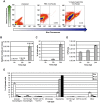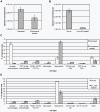Early host cell targets of Yersinia pestis during primary pneumonic plague
- PMID: 24098126
- PMCID: PMC3789773
- DOI: 10.1371/journal.ppat.1003679
Early host cell targets of Yersinia pestis during primary pneumonic plague
Abstract
Inhalation of Yersinia pestis causes primary pneumonic plague, a highly lethal syndrome with mortality rates approaching 100%. Pneumonic plague progression is biphasic, with an initial pre-inflammatory phase facilitating bacterial growth in the absence of host inflammation, followed by a pro-inflammatory phase marked by extensive neutrophil influx, an inflammatory cytokine storm, and severe tissue destruction. Using a FRET-based probe to quantitate injection of effector proteins by the Y. pestis type III secretion system, we show that these bacteria target alveolar macrophages early during infection of mice, followed by a switch in host cell preference to neutrophils. We also demonstrate that neutrophil influx is unable to limit bacterial growth in the lung and is ultimately responsible for the severe inflammation during the lethal pro-inflammatory phase.
Conflict of interest statement
The authors have declared that no competing interests exist.
Figures




References
-
- Inglesby TV, Dennis DT, Henderson DA, Bartlett JG, Ascher MS, et al. (2000) Plague as a biological weapon: medical and public health management. Working Group on Civilian Biodefense. JAMA: the journal of the American Medical Association 283: 2281–2290. - PubMed
-
- Krishna G, Chitkara RK (2003) Pneumonic plague. Seminars in respiratory infections 18: 159–167. - PubMed
Publication types
MeSH terms
Grants and funding
LinkOut - more resources
Full Text Sources
Other Literature Sources
Medical

